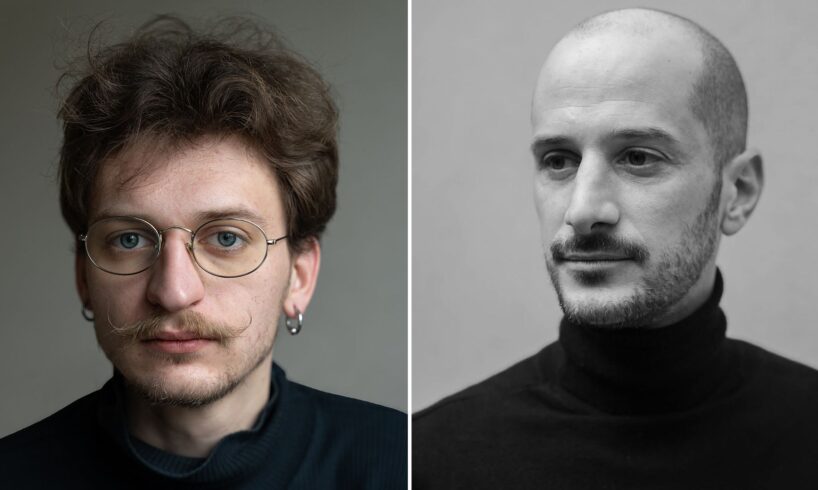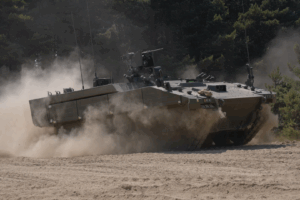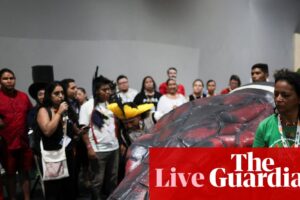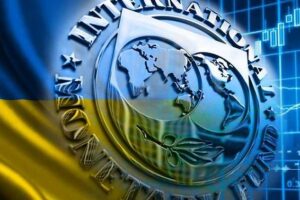
L: George Ivanchenko, a Ukrainian photojournalist, was seriously wounded in a targeted Russian drone attack while reporting on the front line in eastern Ukraine on Oct. 3, 2025. (Olha Kovalyova) R: French reporter and photographer Antoni Lallican was killed in the same Russian drone strike on Oct. 3, 2025. (Antoni Lallican/Instagram)
Throughout Russia’s full-scale invasion of Ukraine, journalists have faced routine attacks by Moscow’s forces — a threat now compounded by the spread of advanced drone technology that makes front-line reporting even more dangerous.
Ukrainian photographer George Ivanchenko and his French colleague Antoni Lallican became victims of such an attack on Oct. 3, when a Russian first-person view (FPV) drone struck them during a reporting trip in Ukraine’s war-torn east.
“It was a targeted strike by an FPV drone. I’m alive. My leg was amputated. My closest friend, brother, and mentor, Antoni Lallican, is dead,” Ivanchenko wrote on Facebook just days after the attack while undergoing treatment at a hospital.
The two journalists were in Donetsk Oblast at the time, where they traveled to document stories of civilians near the front line amid the ongoing Russian push to advance in the area.
They had planned to leave the region on the day of the attack, but decided to make one last stop to film the 4th Mechanized Brigade’s work near Komyshuvakha, around 20 kilometers (12 miles) from the front line.
“They were filming fortifications, relatively far from active combat. Several times, there were warnings of drones in the air. The guys went down into a dugout to wait until it was safe again,” Olha Kovalyova, George’s close friend and colleague, told the Kyiv Independent.
The strike came when they stepped outside the dugout.
“They went out, talking about heading back. Suddenly, they saw a drone circling, and then it turned back and flew straight at them. George fell to the ground and realized he was wounded. It was a direct hit on Antoni. He died instantly,” Kovalyova says, citing George’s recollection of the attack.
Ruslan, a Ukrainian soldier, carries wounded Ukrainian photojournalist George Ivanchenko into a van to take him to a stabilization point on the front line in eastern Ukraine on Oct. 3, 2025. Ivanchenko was wounded in a Russian drone attack that also killed his French colleague Antoni Lallican. (George Ivanchenko/Instagram)
The 4th Mechanized Brigade later said that both journalists wore protective gear clearly marked “PRESS.”
Reporters Without Borders, an international non-profit organization that focuses on safeguarding press freedom, confirmed on Oct. 10 that the strike was a targeted attack by a Russian drone. Shortly after Lallican’s death, Russian Telegram channels labeled him a “propagandist” and openly encouraged the killing of journalists.
Attacking journalists is considered a grave violation of the laws and customs of war. Yet since the beginning of the full-scale invasion, at least 19 media workers have been killed by Russian forces while on assignment, according to Ukraine’s Institute of Mass Information (IMI).
As of Oct. 9, Russia has killed at least 133 media workers in Ukraine, including those who had joined the military, and committed 848 crimes against journalists and media outlets, according to IMI.
Despite the ever-increasing danger — as targeting individuals, whether soldiers or civilians, becomes easier with the evolution of drone technology — journalists continue to play a vital role in documenting Russia’s aggression and its human cost.
“I knew they were going to Donetsk Oblast, and I knew it would be dangerous. We all understand the risks, and we still go to work. What other choice do we have?” Kovalyova says. Kovalyova is a photographer and a senior project manager at the Ukrainian Association of Professional Photographers, where Ivanchenko is a member.
Ukrainian photojournalist George Ivanchenko (C) with his close ones after his injury in Dnipro, Ukraine, on Oct. 6, 2025. (Taras Fedorenko)
‘Brave but not reckless’
At 25, Ivanchenko had already spent years documenting the war that took his home and shaped his work.
He began documenting the war during the first month of Russia’s full-scale invasion in February 2022 as a freelance photographer — first in his native Borodianka near Kyiv, where his family lost everything to the occupation, and later on the front line in the east.
Ivanchenko spent nearly a month in the city of Bakhmut, now occupied by Russian forces, living with civilians in basements to document their lives. In April, his car was destroyed by a Russian shell while he was working near Chasiv Yar.
His work centers on the transformation of environments shaped by war, the changing landscapes, and the impact on the lives of civilians.
For the Kyiv Independent, he contributed to stories about Russia’s offensive in Donetsk Oblast, the toll of war on Sumy Oblast’s farmers, and the Ukrainian teenagers growing up during wartime.
Ukrainian photojournalist George Ivanchenko in a dugout near Toretsk, Donetsk Oblast, Ukraine, on March 16, 2024. (Olha Kovalyova)
“He isn’t afraid of anything. He is brave, unstoppable but not reckless. He knows where the line is and has never crossed it,” Olha says.
After the Oct. 3 attack, Ivanchenko was quickly evacuated, but he had already lost too much blood, and doctors had to amputate his leg.
“Six people donated blood for him. It was a mine-blast injury — the veins and arteries in his leg were torn apart by the explosion. Shrapnel is still lodged in his arms, back, and stomach,” Kovalyova says.
“Emotionally, he’s struggling even more than physically. Antoni’s loss has hit him very hard. They were very close friends. He wouldn’t have gone on that trip with anyone else.”
“Our deployments together were unique. You were unique. It hurts deeply that it happened this way,” Ivanchenko wrote.
Lallican, a Paris-based reporter and photographer, had spent years covering social and humanitarian crises in conflict zones around the world. He had worked in Ukraine since March 2022, and was honored with the prestigious Victor Hugo Prize in 2024 for his reporting.
“Antoni had a lot of experience in conflict zones. So we believed they would be fine. I felt calmer knowing they were together,” Olha says.
Lallican became the 13th journalist to die in the line of duty in Ukraine since 2022, according to IMI.
The European and International Federations of Journalists said this was the first time a journalist had been killed by a drone in Ukraine.
Ukrainian photojournalists George Ivanchenko (L) and Olha Kovalyova (R) in Donetsk Oblast, Ukraine, in December 2024. (Vladyslav Krasnoshchok)
Kovalyova was herself wounded by artillery fire while working on the front line a year earlier. Her right arm still hasn’t fully recovered from that injury.
“George and another colleague, Vladyslav Krasnoshchok, pulled me out of that crisis. Now it’s my turn to help him,” Kovalyova says.
She has launched a fundraiser to support Ivanchenko’s recovery.
Ivanchenko and Kovalyova are part of a generation of Ukrainian reporters and photographers who have risked everything to document Russia’s war. Many of them work as freelancers, with no institutional support or insurance.
“Independent journalists risk everything — their lives, their limbs — to document this war, often working side by side with soldiers. But they are not protected. When I was injured, it was on me and those around me. Now George is going through the same,” Kovalyova says.
The Kyiv Independent shares a selection of George’s recent work documenting Russia’s full-scale invasion of Ukraine.
The land burns after shelling in the village of Nova Poltavka, Donetsk Oblast, on July 2, 2024. (George Ivanchenko / The Kyiv Independent)Ukrainian police help civilians evacuate from the Vovchansk district to safe zones due to the Russian offensive in Kharkiv Oblast, Ukraine, on May 15, 2024. (George Ivanchenko / Anadolu via Getty Images)A crater left by a Russian shell at the Central City Stadium in Mykolaiv, Ukraine, on June 28, 2022. (George Ivanchenko)A man stands in front of a grain hangar with a roof riddled with wholes due to Russian attacks in Mykolaiv Oblast, Ukraine, on June 6, 2022. (George Ivanchenko)Three photographs from the series “Warhole,” created through a door peephole to offer a different view of the war. (George Ivanchenko)Enver, 46, a local resident, helps to put out the fire in the wheat fields, burning after the shelling in the front-line village of Nova Poltavka, Donetsk Oblast, on July 2, 2024. (George Ivanchenko / The Kyiv Independent)Illia, 17, talks with his friend Nastia on the rooftop of a damaged 16-story building in Northern Saltivka in Kharkiv, Ukraine, on May 27, 2025. Before Russia’s full-scale invasion, Illia lived in Northern Saltivka with his family. In the early days of the war, they fled to their dacha (summer house), which was soon occupied. At the age of 14, he escaped from the occupied part of Kharkiv Oblast through Russia. He now studies psychology, volunteers, and teaches soldiers how to operate drones. (George Ivanchenko / The Kyiv Independent)The aftermath of the Kakhovka Dam explosion on June 7, 2023. Russian forces blew up the Kakhovka Dam in Kherson Oblast a day earlier, flooding 600 square kilometers and devastating southern Ukraine. (George Ivanchenko)The aftermath of the Kakhovka Dam explosion after Russian forces blew it up a day earlier in Kherson Oblast on June 7, 2023. (George Ivanchenko)Illia (C), 17, a Mavic drone instructor, conducts training for the military at a training ground in Kharkiv, Ukraine, on May 27, 2025. (George Ivanchenko / The Kyiv Independent)A Ukrainian soldier enters a house at an undisclosed location on April 10, 2023. (George Ivanchenko)A flower is seen through barbed wire and dragon’s teeth in Sumy Oblast, Ukraine, on Aug. 17, 2024. (George Ivanchenko)
Source





